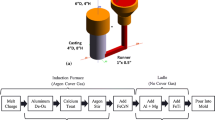Abstract
The use of a new technology that involves inoculating tube steel during casting can save money by eliminating the need for vacuum degassing (production cost $25/ton) and treating the steel on a ladle-furnace unit (production cost $15.70/ton). The cost of such treatment is ∼$4–5/ton. Inoculation of the steel during casting does not require complex equipment and can easily be done in any steelmaking shop. Rolling of the inoculated steel results in a larger yield of useable tubes, and the finished rolled product has better mechanical characteristics and greater corrosion resistance than steel made by the usual technology.
Similar content being viewed by others
REFERENCES
Ya. M. Kolotyrkin and L. I. Freiman, “Role of nonmetallic inclusions in corrosion processes,” in: Symposium on Corroision and Protection from Corrosion, VINITI, Moscow (1978), Vol. 6, pp. 5–52.
G. Taira and K. Koboyashi, “Development of pipes for use in hydrogen sulfide,” in: Symposium on Steels for Gas Pipes and Fittings, Metallurgiya, Moscow (1985), pp. 226–240.
A. G. Mazel’, “Hydrogen-a factor in the stress corrosion cracking of pipelines,” Stroit. Truboprovodov, No. 9, 23–26 (1992).
G. A. Filippov, I. G. Rodionova, O. N. Baklanova, et al., “Corrosion resistance of steel pipelines, ” Tekhnol. Metall., No. 2, 24–27 (2004).
I. G. Rodionov, O. N. Baklanova, and A. I. Zaitsev, “Role of nonmetallic inclusions in acclerating local corrosion processes in oil-field tubing made of low-alloy and carbon steels,” Metally, No. 5, 13–18 (2004).
I. V. Ryabchikov, V. P. Gribanov, N. M. Solov’ev, and R. G. Usmanov, “Energy-and material-saving technologies for obtaining and using complex master alloys,” Stal’, No. 1, 34–36 (2001).
B. F. Belov, A. I. Trotsan, and F. S. Kreidenko, “Decrease in the flake sensitivity of structural steel microalloyed with cerium,” Metallurg, No. 9, 40–41 (2004).
Wei Li Juan, Wang Fuming, Xiang Changxiang, et al., “Effect of lanthanum on ductility improvements in the hot-working of steel 34CrNi3Mo containing residual impurities,” Journal of China Rare Earth Society, 21, No.3, 311–314 (2003).
I. L. Brodetskii, A. I. Trotsan, B. F. Belov, et al., “Alloying cast steel with rare-earth metals to prevent the formation of defects from nonferrous metals,” in: Proceedings of the Tenth International Scientific-Technical Conference, May 12–16, 2003, Zaporozh’e, Zaporozh’e State Technical University (2003), pp. 86–88.
T. Tetyueva and I. Ioffe, “Study of the reasons for the premature failure of steel gas and oil pipelines,” Nauchno-Tekh. Vestn. YuKOS, No. 8, 2–8 (2003).
G. N. Okorokov, V. M. Parshin, A. V. Kuklev, et al., “Evaluating the effectiveness of using cored wire to treat metal,” Elektrometallurg., No. 4, 21–25 (2000).
Author information
Authors and Affiliations
Additional information
__________
Translated from Metallurg, No. 4, pp. 73–77, April, 2005.
Rights and permissions
About this article
Cite this article
Golubtsov, V.A., Voronin, A.A., Tetyueva, T.V. et al. Origin of Nonmetallic Inclusions and Ways of Alleviating Their Contamination of Steel. Metallurgist 49, 149–155 (2005). https://doi.org/10.1007/s11015-005-0068-0
Issue Date:
DOI: https://doi.org/10.1007/s11015-005-0068-0




